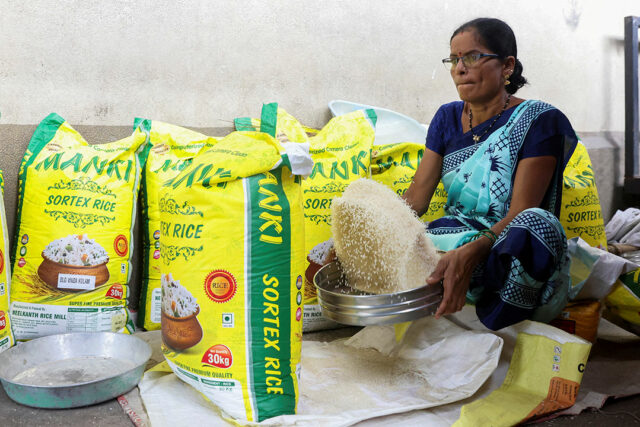By Aaron Michael C. Sy, Reporter
THE PHILIPPINE peso’s steady decline against the dollar — an almost two-year record low — is no longer a black-and-white case of exporters and other dollar earners winning and heavy corporate borrowers losing big time.
The same can be said about the Bangko Sentral ng Pilipinas’ (BSP) steady march toward monetary easing in the coming months for the first time since November 2020, which begs the question of who will win and who will lose once the rate cuts are finally delivered.
Take the case of Mega Prime Foods, Inc., a leading brand of sardines and other canned fish products that is now forced to manage costs and investments more intensely because its packaging, raw materials, finished goods and other key capital expenditures are foreign currency denominated.
“We are not hedged in our revenue and spending,” Chief Executive Officer Michelle Tiu Lim-Chan said in a Viber message. “On the other hand, it is better for our export business, but our primary source of revenue is the domestic market.”
Tricia Anna Enriquez, a 25-year-old freelancer based in Manila, is earning P1,000 ($17) more weekly as the peso, which has lost more than P3 against the dollar this year, continues to dive in value.
 “The dollar is strong, so I earn a lot more now,” she told BusinessWorld. “My usual P15,000-a-week income is now P16,000.”
“The dollar is strong, so I earn a lot more now,” she told BusinessWorld. “My usual P15,000-a-week income is now P16,000.”
The peso closed at P58.305 per dollar on Thursday, strengthening by 1.5 centavos from its P58.32-a-dollar finish on Wednesday. This was the peso’s strongest finish in more than a month or since its P57.97 close on May 28.
It has been trading at the P58-a-dollar level since May, a weakness that the Philippine central bank has attributed to safe-haven demand for the dollar amid geopolitical tensions and hawkish signals from the US Federal Reserve.
John Paolo R. Rivera, president and chief economist at Oikonomia Advisory & Research, blames the Fed, which has kept interest rates at a two-decade high amid stubborn inflation, for the dollar’s strength.
“This benefits exporters and overseas Filipino workers (OFWs) and those earning foreign currency because their dollar earnings now have more value in pesos,” he said in a Viber message.
The BSP’s signals of an early policy easing before the Fed has led to further peso depreciation, Leonardo A. Lanzona, an economics professor at the Ateneo de Manila University, said in an e-mail.
“Indeed, the dollar value has strengthened, but the immediate effect of prospective lowered interest rates here even before the Fed reduces their rates seems to have created greater damage,” he said.
The BSP would probably cut its policy rate after the US Federal Reserve, which had signaled it might start easing as late as December, Finance Secretary Ralph G. Recto said earlier.
Mr. Recto, who is a member of the BSP’s policy-making Monetary Board, expects as much as 150 basis points (bps) of cuts in the next two years.
On the other hand, BSP Governor Eli M. Remolona, Jr. has signaled a rate cut as early as August — potentially before a Fed easing. Total rate cuts this year could go as high as 50 bps, he said.
The Monetary Board has kept its benchmark rate steady at a 17-year high of 6.5% since October 2023 after 450 bps in rate increases to tame prices.
Jonathan L. Ravelas, senior adviser at Reyes Tacandong & Co., said the growing sea tensions between the Philippines and China are adding to the peso jitters.
Local importers are clearly disadvantaged by the weaker peso because their purchases are mostly dollar-denominated, while exporters benefit because their products are now worth more, he pointed out.
DOUBLE-EDGED SWORD
While this is true, the benefits are far from equal among exporters.
“Exporters that generate more local value-added are expected to reap larger benefits,” Trade Undersecretary Jose Edgardo G. Sunico said in a Viber message.
These include resource-based and service exporters such as companies in the information technology, business process management and tourism sectors, he added.
“The impact of a weaker Philippine peso on exports varies across sectors,” Mr. Sunico said.
Exports should benefit as Philippine goods and services become more price competitive, but those that rely heavily on imported raw materials and inputs would benefit less, he added.
“The business outlook will be impacted by these market dynamics, with exporters remaining optimistic about growth, while import-reliant industries are more cautious of the economic challenges posed by a weaker peso,” Mr. Sunico said.
While importers are probably hurt by the depreciating peso, they are far from helpless, Sergio Ortiz-Luis, Jr., president of the Philippine Exporters Confederation, Inc., said by telephone.
Filipino importers particularly in the agriculture sector are now trying to use local raw material substitutes to ease the blow from the strong dollar, he said.
“So their consumable goods will have fewer import [components],” he said in mixed English and Filipino.
The peso’s persistent weakness can also be a double-edged sword for Filipino families that rely on a relative who works overseas.
A strong dollar means more value in remittances sent by OFWs, Ellene A. Sana, executive director of the Center for Migrant Advocacy, said by telephone.
But they could likewise end up sending less dollars given the higher peso value of these remittances, Mr. Ravelas said.
Cash remittances from OFWs rose by 3.1% year on year to $2.562 billion in April — the fastest since December but the lowest in 11 months, according to BSP data. Month on month, remittances fell by 6.4%.
The peso depreciated by P1.52 against the dollar that month.
OFW families like most Filipinos obviously have to contend with rising prices including food.
“Inflation is rising faster compared with the peso’s weakening, so the effect on OFWs could still be negative,” Ms. Sana said.
“If you’re sending the same amount of dollars, the worth in peso could be higher but it will afford less goods,” she said.
Despite remittance optimism due to the dollar’s strength, OFWs are still wary about sticky inflation, Ms. Sana said.
Inflation eased to 3.7% in June from 3.9% in May, still within the BSP’s 2-4% annual target. It averaged 3.5% in the first half.
“You have to connect it to the end user of the money. Your end user, who is in the Philippines, is finding inflation problematic,” Ms. Sana said.
Mr. Lanzona said local companies are more exposed to the weak peso.
“This group has been among the most active spenders and borrowers of dollar-linked instruments over the past decade, either by choice due to lower cost or by necessity given the [limited] size of domestic funding sources,” he said.
While companies in other Southeast Asian countries are standing up to the dollar, local companies big and small face difficulties in expanding production or exports and are failing to take advantage of the depreciation, he added.
The peso would likely continue its free fall in the coming months due to inflation and slowing demand for domestic funds, which could force the BSP to intervene in the currency market, the economist said.
It could also keep rates high, which could slow economic growth targeted at 6-7% this year, he pointed out. The Philippine economy grew by 5.7% in the first quarter, slower than expected.
Mr. Ravelas expects a persistently weak peso until the Fed finally begins its easing cycle.
The peso would probably end the year at P58 as it gets boosted by remittances during the Christmas holiday — still weaker than the P55 to P56 levels reached at the start of the year.











 “The dollar is strong, so I earn a lot more now,” she told BusinessWorld.
“The dollar is strong, so I earn a lot more now,” she told BusinessWorld.
